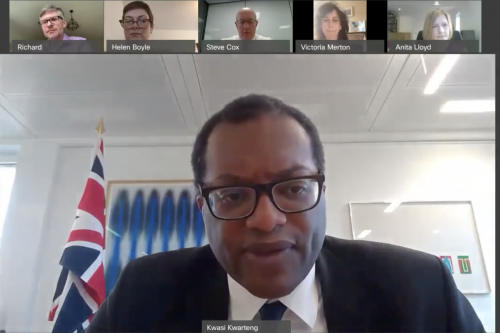460,000 “green collar jobs” could be created by 2030

The Government has announced its ambitions for a green industrial revolution but what does this mean?
This was the question posed to an expert panel at the latest webinar by Squire Patton Boggs.
The session which focused upon the areas of green energy included the Minister of State at the Department for Business, Energy and Industrial Strategy, Kwasi Kwarteng; along with Helen Boyle, regional development manager at Cadent Gas; Richard Gwilliam the head of cluster development at Drax group; Steve Cox, engineering and technical director for Electricity North West and Victoria Merton, director of corporate affairs at the Peel group.
Starting the session Kwarteng provided an update on the Government’s current view. He referred to the recently announced 10-point plan as “extremely significant”, as it brings together his work over the last 18 months as Energy Minister with the 2019 net zero legislation that enshrined in law the UK’s plan to be carbon zero by 2050.
The minister emphasised that in his opinion the key parts of the 10-point plan included the announcements around 2030, including the full carbon capture and storage clusters and 5 gigawatts of hydrogen capacity.
He also cited the economic impact this could have, with the creation of 460,000 “green collar jobs” by 2030, providing a huge industrial opportunity for the UK.
Boyle added that the announcement from Government particularly around hydrogen had sent a “really strong signal to the market concerning investment and [about] helping to get that [industry] going”.
She added however we must remember it’s not a one size fits all approach and the solution for the future of energy is dependent on an area by area basis. Despite this she is an advocate of “whole system planning approach” across all energy sectors – an example of this is the work being undertaken by Cadent Gas and Electricity North West to build a pathway to net zero for Greater Manchester, Lancashire and Cumbria.
She explains this sort of collaboration gives “all the stakeholders involved in the debate a clear view and signals which allow them to make those decisions, which the avoid the paralysis caused by ambiguity in the future of energy. Boyle states she’s seen local authorities and large organisations pause because they don’t have a clear path and therefore don’t want to spend money and which results in a situation where they have a stranded asset in a couple of years because they went down the wrong path.
Merton added that three of the key areas that need to be looked at in the move towards net zero is heavy industry, transport and heat. She explains that retrofitting homes to make them carbon neutral is going to be a huge industry and take time, for transport she cited that the maritime industry is already making “great strides” with the use of ammonia as a hydrogen derivative for decarbonising fuel. While industrial clusters such as HyNet in the North West and projects in Teesside and the Humber will be the first way that clean energy is delivered at scale.
The move of clusters is focused around the opportunities of hydrogen but Merton highlights that although the North is as a result of these clusters at the leading edge of the transition to cleaner and greener energy, it needs to be done in an economically viable way and consider innovative technologies.
Gwilliam picks up the energy usage point, stating that wind and solar have already started to play a key part in the energy mix but that there needs to be a green alternative for when the wind isn’t gusting and the light is not hitting the solar panels.
He explains: “[We] have this sort of dependency that we’ve had in the system, for many years. The work we’re doing at the power station [Drax] is focused on using biomass, but this alone probably isn’t going to work, so we’re looking at how we attach carbon capture and storage technology to this – which gives us BECCS (bioenergy with carbon capture and storage)”.
He adds that if this scheme was rolled out across all four biomass generators that are currently at Drax it would take out 16m tonnes of carbon dioxide from the atmosphere per year, which is the equivalent of planting a forest the size of Wales.
Speaking of the benefits of BECCS Gwillam concluded “We get flexibility, the system [needs, as it] can run up and down, as the demand requires, we also get the environmental benefit that comes with it. [This means it can] complement the large levels of wind and solar [and] make sure that we can keep balancing the system to cope with the demand.”
For Cox the flexibility that the energy sector needs, is key but he points out that energy efficiency has a huge role to play too.
He said: “[Energy efficiency] has probably been the most successful change agent for energy and carbon reductions over the past 10-15 years.”
He adds that a further 60% of emissions could be saved through energy efficiency measures.
Cox adds that the move towards greener energy is one that is backed by customers. He said: “Customers really value the greening debate and agenda and our customers are really bought into it. However, above all else [customers] value security of supply and we must never lose sight of that.”
Closing the session, Kwasi Kwarteng MP echoed Cox, he said: “In order to reach net zero by 2050 we’re going to have to bring the public along with us. I think a lot of people understand that [things are changing due to climate change] in an intuitive way. But I think it’s right to say that more work needs to be done to bring larger groups of people, along with us on this journey.”
If you would like to watch the session in full, you can do so by clicking here.
Squire Patton Boggs is one of the headline partners for the upcoming virtual sustainability conference, In The Circle, that is aiming to support ensure businesses of all sizes to seize the opportunities presented by the Government’s multi-billion-pound plan for a Green Industrial Revolution.








